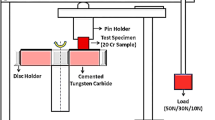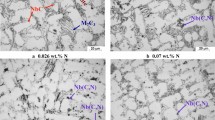Abstract
High-chromium cast irons (HCCIs) are widely used in many industrial processes involving wear and corrosion, such as oil sands mining and slurry handling in the oil sands industry. In very harsh mining environment and severe working conditions, conventional HCCIs, however, often exhibit a short service life. Great efforts have been made to improve the performance of HCCIs. One of the trials is to extend the chromium content to a higher level, e.g., 45 wt%, and widen the carbon content to a range of 1–6 wt%. In this study, we investigated the wear behavior of 45-series (Fe–45 wt%Cr with 1–6 wt%C) and observed that 45-4 HCCI (Fe–45 wt%Cr–4 wt%C) had the highest hardness and exhibited remarkably high resistance to abrasion and erosion. Microstructure analysis showed that the primary carbides in 45-4 had a core–shell structure. The outer shell was M23C6, while the inner core was harder M7C3, confirmed by the EBSD technique. The ferrous matrix was eutectic colony with martensite and fine M23C6 carbides. Micro-mechanical probing in combination with finite element analysis demonstrated that the core–shell structure helped reduce the interfacial stress, thus enhancing the hardness and overall wear resistance of the material.











Similar content being viewed by others
References
Jones, M., Llewellyn, R.J.: Erosion–corrosion assessment of materials for use in the resources industry. Wear 267, 2003–2009 (2009)
Dogan, O.N., Hawk, J.A., Laird, G.: Solidification structure and abrasion resistance of high chromium white irons. Metall. Mater. Trans. A 28, 1315–1328 (1997)
Wu, X.J., **ng, J.D., Fu, H.G., Zhi, X.H.: Effect of titanium on the morphology of primary M7C3 carbides in hypereutectic high chromium white iron. Mater. Sci. Eng., A 457, 180–185 (2007)
Llewellyn, R.J., Yick, S.K., Dolman, K.F.: Scouring erosion resistance of metallic materials used in slurry pump service. Wear 256, 592–599 (2004)
Chang, C.M., Hsieh, C.C., Lin, C.M., Chen, J.H., Fan, C.M., Wu, W.T.: Effect of carbon content on microstructure and corrosion behavior of hypereutectic Fe–Cr–C claddings. Mater. Chem. Phys. 123, 241–246 (2010)
Clark, H.M., Llewellyn, R.J.: Assessment of the erosion resistance of steels used for slurry handling and transport in mineral processing applications. Wear 250, 32–44 (2001)
Tang, X.H., Chung, R., Li, D.Y., Hinckley, B., Dolman, K.: Variations in microstructure of high chromium cast irons and resultant changes in resistance to wear, corrosion and corrosive wear. Wear 267, 116–121 (2009)
Tang, X.H., Chung, R., Pang, C.J., Li, D.Y., Hinckley, B., Dolman, K.: Microstructure of high (45 wt%) chromium cast irons and their resistance to wear and corrosion. Wear 271, 1426–1431 (2011)
Zhi, X., **ng, J.D., Gao, Y.M., Fu, H.G., Peng, J.Y., **ao, B.: Effect of heat treatment on microstructure and mechanical properties of a Ti-bearing hypereutectic high chromium white cast iron. Mater. Sci. Eng., A 487, 171–179 (2008)
Zhang, H., Li, D.Y.: The mechanisms of interfacial failure for lateral force-sensing microindentation test: finite element analysis. Acta Mater. 56, 6197–6204 (2008)
ASM Handbooks Online, vol. 3: alloy phase diagrams, C–Cr–Fe ternary phase diagrams; C–Cr–Fe isothermal section at 1000C (88 Ray 60)
Vyârostkovâ, A., Kroupa, A., Janovec, J., Svoboda, M.: Carbide reactions and phase equilibria in low-alloy Cr–Mo–V steels tempered at 773–993 K. Part I: experimental measurements. Acta Mater. 46, 31–38 (1998)
Kroupa, A., Vyârostkovâ, A., Svoboda, M., Janovec, J.: Carbide reactions and phase equilibria in low-alloy Cr–Mo–V steels tempered at 773–993 K. Part II: theoretical calculations. Acta Mater. 46, 39–49 (1998)
Wiengmoon, A., Chairuangsri, T., Pearce, J.T.H.: A microstructural study of destabilised 30%Cr–2.3%C high chromium cast iron. ISIJ Int. 44, 396–403 (2004)
Wiengmoon, A., Chairuangsri, T., Brown, A., Brydson, R., Edmonds, D.V.E., Pearce, J.T.H.: Microstructural and crystallographical study of carbides in 30wt% Cr cast irons. Acta Mater. 53, 4143–4154 (2005)
Pearce, J.T.H., Elwell, D.W.J.: Duplex nature of eutectic carbides in heat-treated 30% chromium cast iron. Mater. Sci. Lett. 5, 1063–1064 (1986)
Pearce, J.T.H.: High chromium cast irons to resist abrasive wear. Foundryman 95, 156–166 (2002)
Lin, C.M., Chang, C.M., Chen, J.H., Wu, W.T.: Hardness, toughness and cracking systems of primary (Cr, Fe)23C6 and (Cr, Fe)7C3 carbides in high-carbon Cr-based alloys by indentation. Mater. Sci. Eng., A 527, 5038–5043 (2010)
Acknowledgments
The authors are grateful for the support from the Natural Science and Engineering Research Council of Canada, Alberta Innovative—Technology Future (AITF), and Imperial Oil Ltd. The authors would also like to thank the Microstructural Analysis Unit at the University of Technology Sydney for the EBSD analysis.
Author information
Authors and Affiliations
Corresponding author
Rights and permissions
About this article
Cite this article
Tang, X.H., Li, L., Hinckley, B. et al. Beneficial Effects of the Core–Shell Structure of Primary Carbides in High-Cr (45 wt%) White Cast Irons on Their Mechanical Behavior and Wear Resistance. Tribol Lett 58, 44 (2015). https://doi.org/10.1007/s11249-015-0522-5
Received:
Accepted:
Published:
DOI: https://doi.org/10.1007/s11249-015-0522-5




